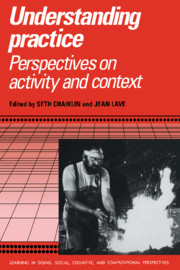Book contents
- Frontmatter
- Contents
- Series foreword
- List of contributors
- Part I Introduction
- Part II Learning craftwork
- 2 Learning to navigate
- 3 Developmental studies of work as a testbench of activity theory: The case of primary care medical practice
- 4 Re-searching psychotherapeutic practice
- 5 Thinking and acting with iron
- 6 Artificial intelligence as craftwork
- 7 Behavior setting analysis of situated learning: The case of newcomers
- Part III Learning as social production
- Part IV Conclusion
- Author index
- Subject index
- Learning in Doing: Social, Cognitive, and Computational Perspectives
7 - Behavior setting analysis of situated learning: The case of newcomers
Published online by Cambridge University Press: 06 January 2010
- Frontmatter
- Contents
- Series foreword
- List of contributors
- Part I Introduction
- Part II Learning craftwork
- 2 Learning to navigate
- 3 Developmental studies of work as a testbench of activity theory: The case of primary care medical practice
- 4 Re-searching psychotherapeutic practice
- 5 Thinking and acting with iron
- 6 Artificial intelligence as craftwork
- 7 Behavior setting analysis of situated learning: The case of newcomers
- Part III Learning as social production
- Part IV Conclusion
- Author index
- Subject index
- Learning in Doing: Social, Cognitive, and Computational Perspectives
Summary
Many human actions in everyday life occur in settings where actions are highly constrained and organized. Some years ago I started research on how newcomers adapt to such novel, unfamiliar, and coercive settings: The work was done in libraries and university career planning and placement centers (cf. Fuhrer, 1988, 1989a, 1990b). Questions were asked about the experience and behavior of newcomers to the settings, about the structure and dynamics of settings when invaded by the uninitiated, and about the reconciliation between the novices as individual persons and the settings as extra individual systems of activity. These questions are of both practical and theoretical importance: practical, because modern societies expose people to unfamiliar settings very frequently due to technological change, organizational developments, easy migration, and so forth; theoretical because answers to these questions require advancement in our understanding of the regulation of individual or collective actions as part of sociophysical or cultural environments.
A general theme that lies behind the discussion of research in this chapter is that learning (or knowledge acquisition) is inevitably situated. Learning takes place in real-life settings, under real performance requirements on actual individuals, and is vulnerable therefore to social influences that may arise at any time. Both retrospective verbal protocols and data of a behavioral path analysis were gathered (among other data; see Fuhrer, 1989a) from newcomers who learned to prepare a job application in a career planning and placement center.
Here is a typical situation: Imagine a freshman who comes into a career planning and placement center to look for a part-time summer job opportunity at a southern Californian public transport company.
- Type
- Chapter
- Information
- Understanding PracticePerspectives on Activity and Context, pp. 179 - 212Publisher: Cambridge University PressPrint publication year: 1993
- 7
- Cited by



